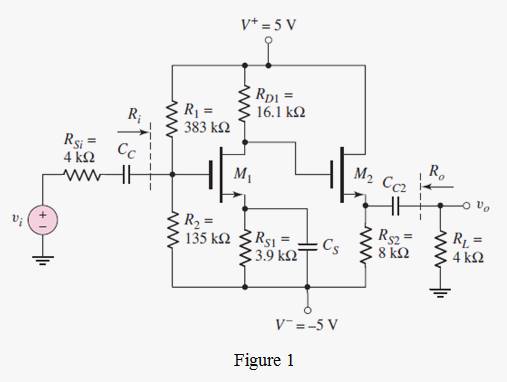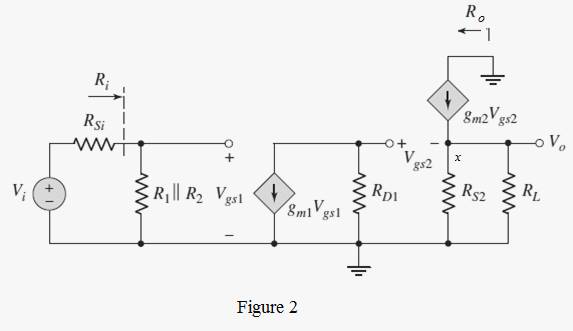
The transistor parameters of the circuit in Figure 4.49 are
(a)
The drain current and the individual drain to source voltages of the transistors in NMOS cascade circuit with given transistor parameters.
Answer to Problem 4.12TYU
The quiescent drain current of the transistors are
The drain to source voltage at Q-point for the transistors are
Explanation of Solution
Given Information:
An NMOS cascade device with transistor parameters
Calculation:
Consider the common source amplifier in cascade with a source follower circuit in Figure 1. Here, transistor M1 is operated in common-source configuration and M2 is operated in common-gate configuration.

The drain current and gate to source voltage of both the transistors are the same.
The drain current is given by,
The gate to source voltage is given by,
Considering the transistor M1 , the gate voltage for the transistor M1 is,
Substituting the resistance values from the circuit and the bias voltage, the gate voltage is obtained as,
Now, the source voltage is ,
Substituting the resistance value,
Thus, gate source voltage in terms of first transistor is ,
Substituting the expression for gate source voltage in (1), the drain current for transistor M1 in quiescent condition is,
On rearranging the above equation, the final quadratic equation is obtained as
Since the transistor is in saturation, the lower value among the two is considered. Hence, the drain current for the first transistor is,
Now, the drain to source voltage for the transistor M1 can be expressed as,
Substituting the values of parameters,
Considering the transistor M2, the gate voltage is same as the drain voltage of transistor M1, given by
The source voltage is given by,
The gate source voltage is therefore,
The drain current for transistor M2 is given by,
Solving the above expression, the final quadratic equation is obtained as,
Thus, the equation is given by,
Since the transistor is in saturation, the lower value among the two is considered. Hence, the drain current for the second transistor is,
Now, the drain to source voltage for the transistor M2 at Q-point can be expressed as,
Substituting the values of parameters,
(b)
The voltage gain of an NMOS cascade circuit with given transistor parameters.
Answer to Problem 4.12TYU
The voltage gain is given by
Explanation of Solution
Given Information:
:An NMOS cascade device with transistor parameters
Calculation:
Consider the common source amplifier in cascade with a source follower circuit in Figure 1. Here, transistor M1 is operated in common-source configuration and M2 is operated in common-gate configuration.
The voltage gain of the circuit is expressed as,
Here,
Now, the transconductance of the amplifier is given by,
Considering quiescent value of drain current,
Similarly, the transconductance of the second transistor is,
Substituting the transconductance values and the resistor values, the voltage gain is given by,
(c)
The output resistance of an NMOS cascade circuit with given transistor parameters.
Answer to Problem 4.12TYU
The output resistance is given by
Explanation of Solution
Given Information:
An NMOS cascade device with transistor parameters
Calculation:
The output resistance of the circuit is that of the output resistance of the emitter follower circuit which is low. It can be deduced from the small signal equivalent circuit shown below.

As it appears in the circuit, the output resistance of the circuit excluding the load resistance is obtained by considering the Kirchoff’s current law at the output node x which is,
This implies, the output resistance is given by,
Substituting the resistance and transconductance value,
Want to see more full solutions like this?
Chapter 4 Solutions
Microelectronics: Circuit Analysis and Design
- Show that the drain current IDQ is approximately equal to 3.65 mA (graphically or otherwise). Then calculate VDSQ.arrow_forward1.simple topic proposal related to electrical engineering >research problems >working hypothesisarrow_forward(a) What is the ratio iC/iE as shown for vI =0.8 V? If needed, you may use the parameters inTable shown. (b) For vI = 1.0 V? (c) For vI = 0.6 V?(d) What is the dc input voltage vI required foriC/iE = −1?arrow_forward
- Question 6 Explain how the effective resistance of the transistor works in a voltage divider circuit (while constructing a common-emitter current amplifier) Full explain this question and text typing work only thanksarrow_forwardFor the circuit in the figure, find the ones requested in the questions by using the following values? Vcc= 23 V, β=66, RB=506 kΩ, RC=4,4 kΩ, RE=1,5 kΩ IE=? VCE=? VCB=?arrow_forwardCould you please go more in depth about how to create the ac equivalant model? thank youarrow_forward
- Project 3: - Design MCU based system to form the following state machine? Proj4:- redesign the project using active low method (method 2) for LEDs? Show all design parts (the circuit and the program) and the state machine diagram.arrow_forwardGiven: Vth is 1.2V and k is 0.5 mA/V² Solve for the following with at least 4 significant figures. Current is in mA and Voltages in V. 1. Id, Vgs, Vds. 2. Verify your MOSFET's mode of operation.arrow_forwardHelping tags: Electric Circuit Theory, Circuits, Electronics EngineeringHelp me answer the questions, the given is just the same. Will upvote, just pls show complete solutions and explain if necessary. Thanks!arrow_forward
- Discussion 4.1 Digital Filters With your current knowledge about signals, what are digital filter is used for?arrow_forward(a) Find the Q-point for the transistor in the circuit in Fig. P4.114(a) if V DD =+12 V. (b) Repeat for the circuit in Fig. 4.114(b)arrow_forwardThe first step in determining the AC equivalent model for a transistor is setting all dc sources to ____ and replacing them by a _______ equivalent a.Infinity, short circuit b.Infinity, open circuit c.Zero, short circuit d.None of thesearrow_forward
 Introductory Circuit Analysis (13th Edition)Electrical EngineeringISBN:9780133923605Author:Robert L. BoylestadPublisher:PEARSON
Introductory Circuit Analysis (13th Edition)Electrical EngineeringISBN:9780133923605Author:Robert L. BoylestadPublisher:PEARSON Delmar's Standard Textbook Of ElectricityElectrical EngineeringISBN:9781337900348Author:Stephen L. HermanPublisher:Cengage Learning
Delmar's Standard Textbook Of ElectricityElectrical EngineeringISBN:9781337900348Author:Stephen L. HermanPublisher:Cengage Learning Programmable Logic ControllersElectrical EngineeringISBN:9780073373843Author:Frank D. PetruzellaPublisher:McGraw-Hill Education
Programmable Logic ControllersElectrical EngineeringISBN:9780073373843Author:Frank D. PetruzellaPublisher:McGraw-Hill Education Fundamentals of Electric CircuitsElectrical EngineeringISBN:9780078028229Author:Charles K Alexander, Matthew SadikuPublisher:McGraw-Hill Education
Fundamentals of Electric CircuitsElectrical EngineeringISBN:9780078028229Author:Charles K Alexander, Matthew SadikuPublisher:McGraw-Hill Education Electric Circuits. (11th Edition)Electrical EngineeringISBN:9780134746968Author:James W. Nilsson, Susan RiedelPublisher:PEARSON
Electric Circuits. (11th Edition)Electrical EngineeringISBN:9780134746968Author:James W. Nilsson, Susan RiedelPublisher:PEARSON Engineering ElectromagneticsElectrical EngineeringISBN:9780078028151Author:Hayt, William H. (william Hart), Jr, BUCK, John A.Publisher:Mcgraw-hill Education,
Engineering ElectromagneticsElectrical EngineeringISBN:9780078028151Author:Hayt, William H. (william Hart), Jr, BUCK, John A.Publisher:Mcgraw-hill Education,





